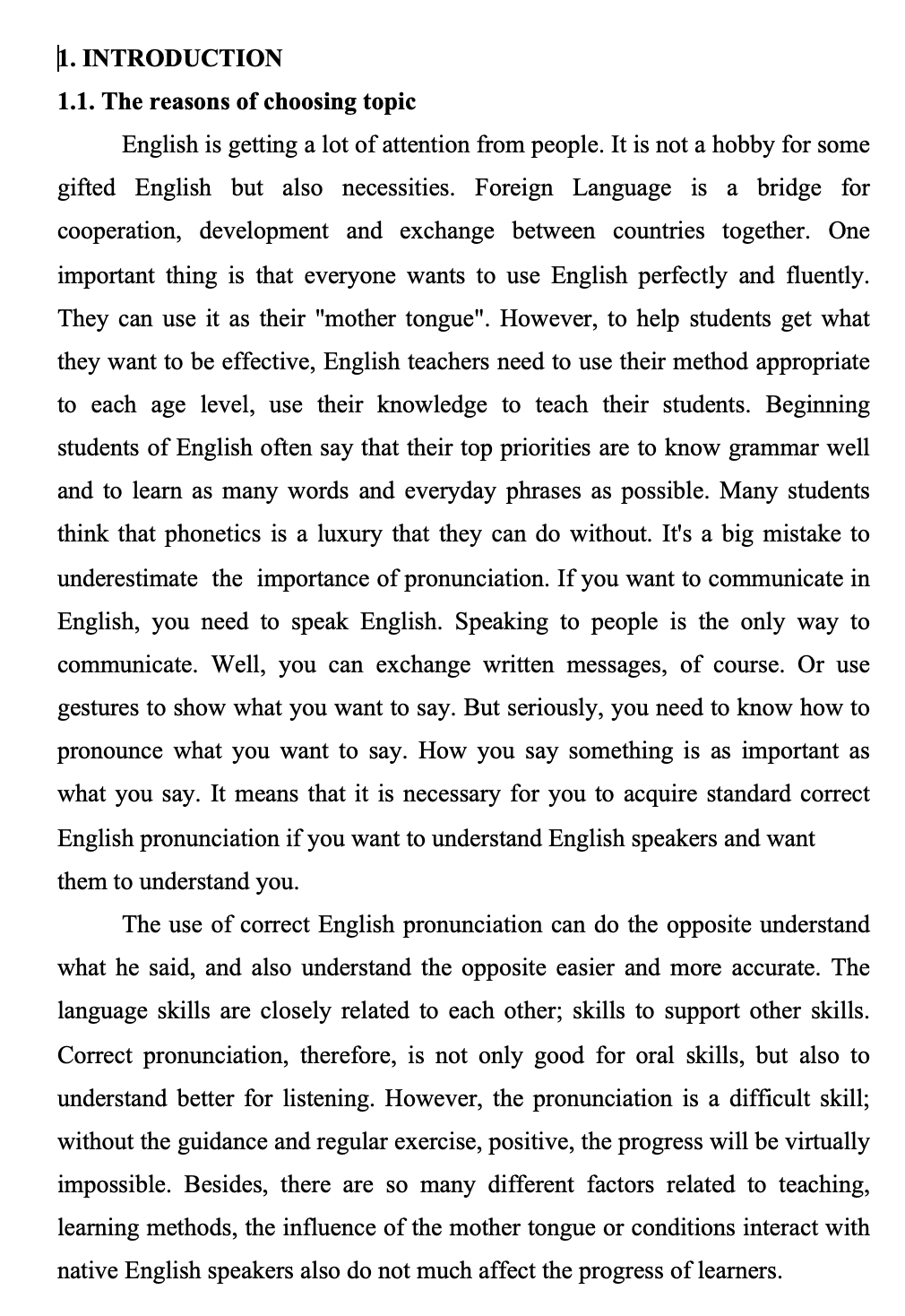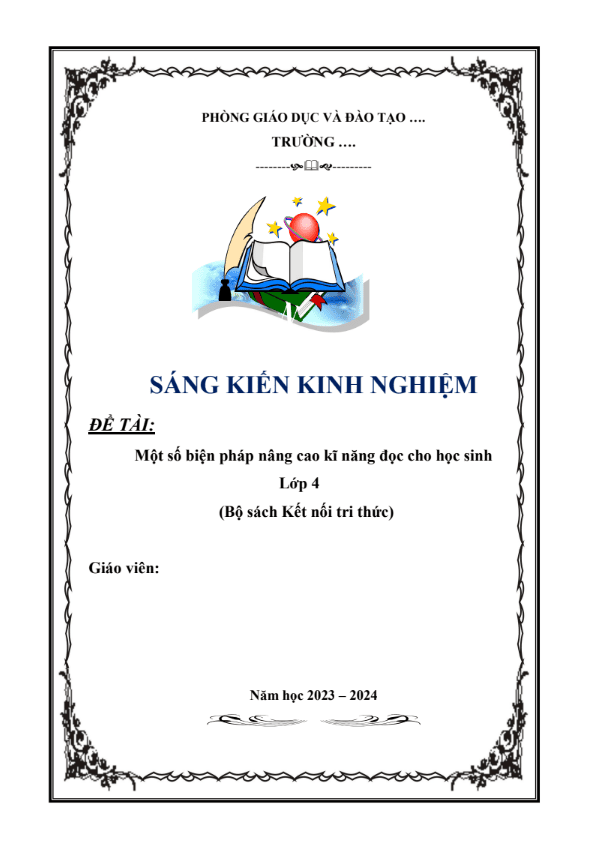SKKN Phonics and teaching phonics for students in grades 3
- Mã tài liệu: BM3030 Copy
| Môn: | Tiếng anh |
| Lớp: | 3 |
| Bộ sách: | |
| Lượt xem: | 427 |
| Lượt tải: | 5 |
| Số trang: | 23 |
| Tác giả: | Đặng Thị Thanh Ngân |
| Trình độ chuyên môn: | Thạc sĩ giáo dục |
| Đơn vị công tác: | Trường Tiểu học Nguyễn Đình Chiểu |
| Năm viết: | 2022-2023 |
| Số trang: | 23 |
| Tác giả: | Đặng Thị Thanh Ngân |
| Trình độ chuyên môn: | Thạc sĩ giáo dục |
| Đơn vị công tác: | Trường Tiểu học Nguyễn Đình Chiểu |
| Năm viết: | 2022-2023 |
Sáng kiến kinh nghiệm “SKKN Phonics and teaching phonics for students in grades 3” triển khai gồm các biện pháp nổi bật sau:
An hour of phonics will be effective if the teacher follows a clear, specific syllabus that makes the syllables easy for the student.
+ The teacher reads the words containing the sound they are learning, the student listens and facing the students to read the sound several times so that the student can hear clearly and observe the movement of the mouth, lips, teeth, tongue of the teacher when pronounced this.
+ The teacher reads a few words that contain the sound they are learning, the
student reads and teacher write words up on the board. The teacher describes the pronunciation (position of the tongue, lips, teeth). The teacher hangs up the diagram showing the location of the tongue, lips, teeth when pronouncing and explaining in detail so students understand. Ask the students to repeat the words on the board and then call each group repeatedly. Finally, the teacher called some students repeatedly. According to the above process, the teacher introduces the second tone. Compare the difference between the second and the first.
Sáng kiến kinh nghiệm “Biện pháp dạy các bài Đạo đức lớp 1 thông qua các trò chơi” triển khai gồm các biện pháp nổi bật sau:
Xác định rõ mục tiêu của bài học để lựa chọn trò chơi cho phù hợp.
Giáo viên cần chuẩn bị đồ dùng, phương tiện phục vụ cho việc tổ chức trò
chơi
Thiết kế một số trò chơi
Trò chơi 1: Ném bóng – Dạy bài: “ Em là học sinh lớp 1”
Trò chơi 2: Cây nở hoa – Khi dạy bài: Bảo vệ hoa và cây nơi công cộng
Trò chơi 3: Tiếp sức – Khi dạy bài: Em và các bạn
Trò chơi 4: Cờ đỏ phất phới – Khi dạy bài: Nghiêm trang chào cờ
Trò chơi 5: Em làm phóng viên- Khi dạy bài: Gia đình em
Trò chơi 6: Ai nhanh, ai đúng – Khi dạy bài: Lễ phép với anh chị, nhường
nhịn em nhỏ
Trò chơi 7: Em là ca sĩ thông minh – Dạy bài: Lễ phép, vâng lời thầy giáo,
cô giáo
- [product_views]
- 1
30.000 ₫
Sáng kiến kinh nghiệm “Biện pháp chỉ đạo giáo viên nâng cao chất lượng dạy học giải toán có lời văn cho học sinh lớp 1“ triển khai gồm các biện pháp nổi bật sau:
Biện pháp 1: Giúp giáo viên nghiên cứu nắm vững nội dung chương trình môn Toán lớp 1.
Biện pháp 2: Giúp giáo viên làm cho học sinh lớp 1 ham thích học môn Toán
Biện pháp 3: Giúp giáo viên biết cách sử dụng,khai thác triệt để đồ dùng dạy học môn Toán lớp 1 cùng với việc ứng dụng CNTT vào dạy học.
Biện pháp 4: Giúp giáo viên nâng cao chất lượng dạy học giải toán có lời văn cho học sinh lớp 1 thông qua cách dạy các dạng bài.
- [product_views]
- 2
30.000 ₫
Mô tả sản phẩm
- INTRODUCTION
1.1. The reasons of choosing topic
English is getting a lot of attention from people. It is not a hobby for some gifted English but also necessities. Foreign Language is a bridge for cooperation, development and exchange between countries together. One important thing is that everyone wants to use English perfectly and fluently. They can use it as their “mother tongue”. However, to help students get what they want to be effective, English teachers need to use their method appropriate to each age level, use their knowledge to teach their students. Beginning students of English often say that their top priorities are to know grammar well and to learn as many words and everyday phrases as possible. Many students think that phonetics is a luxury that they can do without. It’s a big mistake to underestimate the importance of pronunciation. If you want to communicate in English, you need to speak English. Speaking to people is the only way to communicate. Well, you can exchange written messages, of course. Or use gestures to show what you want to say. But seriously, you need to know how to pronounce what you want to say. How you say something is as important as what you say. It means that it is necessary for you to acquire standard correct English pronunciation if you want to understand English speakers and want
them to understand you.
The use of correct English pronunciation can do the opposite understand what he said, and also understand the opposite easier and more accurate. The language skills are closely related to each other; skills to support other skills. Correct pronunciation, therefore, is not only good for oral skills, but also to understand better for listening. However, the pronunciation is a difficult skill; without the guidance and regular exercise, positive, the progress will be virtually impossible. Besides, there are so many different factors related to teaching, learning methods, the influence of the mother tongue or conditions interact with native English speakers also do not much affect the progress of learners.
From the above reasons, I strongly research and write the experience initiative named “Phonics and teaching phonics for students in grade 3”.
I decided to choose this topic with the desire to help students learn English well and can communicate in English. Language learners communicate not only correctly but also self confidently in lessons. This is more excited than they are willing to learn in order to improve their English pronunciation.
1.2. Researching purpose
Developing language (oral skills) through phonics to teach English to young learners.
Developing skills (reading – speaking – pronunciation well)
1.3. Object for studying
Object for studying are young learners at Dong Loi primary schools.
1.4. The methods of researching
Attend classes, learn from your peers, and some of your own experiences.
Observe the knowledge acquisition of students in the teaching process.
Exploring student pronunciation.
Studying teaching materials and teaching materials from the Internet.
- THE CONTENTS
2.1. The basis theory of experimental creation
Through a lot of research material, as well as a combination of theory and practice, we need to rely on the basis of the following reasoning: Faced with a problem of teaching and learning that I think to figure out a way to teach phonics, and the work that I have written to teach phonics method in a class. Teaching phonics to help students create atmosphere language learning correct pronunciation of words in lessons. Much purpose of teaching phonics in a language class is not intended to make students capable pronounced similar to the native because it is not practical, unless the school has a special talent and highly motivated. The goal is to teach phonics to help students gain an ability to pronounce correctly at a certain level to be able to communicate what they want to talk with other people. Phonics is a teaching method used to help children learn to read. Phonics breaks down words into individual sounds and syllables and shows children how each sound fits together to make up a word. Children taught with phonics must learn the different vowel sounds, consonants and regular rules of English grammar. Due to the learner’s native language affects the pronunciation teaching English to people who need to have a certain understanding of the sound system of the learner’s mother tongue to first guess the difficulties and advantages of learner’s pronunciation. Phonics helps your child learn to read and spell. Without this ability, your child cannot be fully literate. Words are like codes and phonics teaches children how to crack the reading code. Phonics is therefore an important part of any reading development program. That is the reason Ministry of Education put on phonics lessons to Primary English .
2.2. The basis reality before using experimental creation
Being a teacher, I love my job, love my children so I always study the psychology of primary school age children (especially pupils in grade 3). They are also at the age of eating, sleeping and the giddy. They remember fast but forget quickly, especially with English subject which is a fascinating subject but different from their mother tongue, so they do not have the help when they do not understand at home. They can only be studied with teachers and friends in class, the fact that I teach in rural schools, many parents do not understand deeply the importance and necessity of the English subject and only focus on cultural subjects like Mathematics, Vietnamese …
The majority of students are not paying attention and investing in foreign languages, they prepare the lesson very sparingly, to deal when they learn this subject very bad. Since then, a number of children with psychological bored with learning English. During school hours, the majority of them are usually passive, lack of flexibility, afraid of reading – saying English and participate in learning lessons very little.
Therefore making interest and consolidating students’ knowledge is an
extremely important and regular work. Because this affects a lot of to the students, a fundamental factor affecting the process of learning a language:
To having the learning quality of the children achieve the best results, it is not an easy thing. So how do they form and develop learning skills most comprehensive? How do they love, deepen their knowledge of the phonics lesson? By any way to help students understand the lesson but not boring, I think that the lesson must be really charismatic, atmosphere during school hours interesting and relaxing.
The organization of teaching English in primary schools meets the needs of students in learning a foreign language elementary and accordant with the requirements of educational development. On the other hand, learning English in primary school will help students get a certain knowledge of English to be able to learn English better when they are at junior high school. Pronunciation in the general case, particularly in primary schools has long been a problem. Many students encounter new words they do not know how to pronounce. Often teachers must International Phonetic form and read to students. Some times the students forget how to pronounce it late. In practically, teaching at my school, I notice that some of them have the ability to read and pronounce very well. Besides, there are some children who have difficulty in pronunciation. They are afraid of the wrong director, afraid of friend’s laugh, resultantly they are shy saying, less communicate and read the words. As well as students mispronounce, this leads to make a marked accent and intonation wrong. So to have methods of teaching reading – speaking – pronunciation well.
TÀI LIỆU LIÊN QUAN
- 0
- 155
- 3
- [product_views]
- 6
- 163
- 4
- [product_views]
- 8
- 188
- 5
- [product_views]
- 3
- 125
- 6
- [product_views]
- 5
- 118
- 7
- [product_views]
- 8
- 110
- 8
- [product_views]
- 7
- 116
- 9
- [product_views]
- 0
- 188
- 10
- [product_views]
- 5
- 192
- 11
- [product_views]
- 1
- 187
- 12
- [product_views]


















